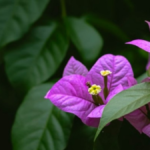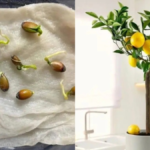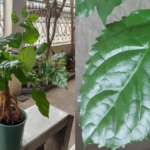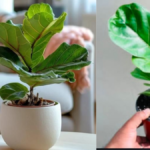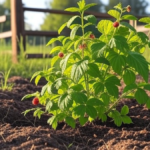Lamb’s Ear plant care Guide indoors and outdoors is easy and beginner-friendly — just give it well-draining soil, bright light, and occasional watering to enjoy its soft, velvety leaves all year round. Learn how to grow Lamb’s Ear plants successfully with this complete care guide.
I have grown Lamb’s Ear (Stachys byzantina) both in my home garden and indoors in pots. With its silver, fuzzy leaves, it adds a beautiful soft texture to any space. Based on my experience, it’s a low-maintenance, rewarding plant if you follow a few simple care steps.
IN THIS ARTICLE
About the Lamb’s Ear Plant and Types
Lamb’s Ear (Stachys byzantina) is a hardy perennial known for its woolly, silvery leaves that feel as soft as a lamb’s ear — hence the name! It grows low to the ground and spreads easily, making it a beautiful ground cover for gardens or a charming potted plant indoors.
Popular types of Lamb’s Ear:
- Stachys byzantina ‘Silver Carpet’: Dense, silvery foliage, rarely flowers.
- Stachys byzantina ‘Big Ears’: Larger, broader leaves.
- Stachys byzantina ‘Cotton Boll’: Produces fluffy seed heads.
Quick Tips for Lamb’s Ear Plant Care
- Light: Full sun outdoors; bright, indirect light indoors.
- Watering: Let soil dry between waterings; avoid overwatering.
- Soil: Well-draining, sandy or loamy soil.
- Temperature: 60–80°F (15–27°C) ideal.
- Humidity: Prefers dry conditions.
- Fertilizer: Feed lightly in spring with balanced fertilizer.
- Propagation: Easily by division or leaf cuttings.
Watering the Lamb’s Ear Plant
Watering Lamb’s Ear correctly is crucial because it dislikes wet feet.
- Outdoors: Water only during dry spells; established plants are drought-tolerant.
- Indoors: Allow the top 1–2 inches of soil to dry before watering.
Pro Tip: Water at the base, not over the leaves, to prevent fungal diseases.
Best Soil for Lamb’s Ear
The right soil helps prevent rot and promotes healthy growth.
- Use well-draining, gritty soil — a cactus mix or garden soil with added sand works great.
- Outdoor gardens should avoid heavy clay soils unless amended with compost and sand.
Sunlight Requirements for Lamb’s Ear
Sun is important for that lovely silvery shine.
- Outdoors: Prefers full sun (6+ hours a day).
- Indoors: Place near a bright window but protect from harsh afternoon rays to avoid leaf scorch.
If grown in too much shade, it may get leggy and less attractive.
Humidity and Temperature Needs
Lamb’s Ear loves dry and warm conditions.
- Ideal indoor temperature: 60–80°F (15–27°C).
- Low humidity is preferred — high humidity can encourage mold and mildew on the fuzzy leaves.
In colder areas, outdoor plants may die back in winter but usually return in spring.
Fertilizing Lamb’s Ear
Lamb’s Ear is not a heavy feeder.
- Use a balanced, diluted fertilizer once at the start of the growing season (spring).
- Avoid over-fertilizing, which can cause lanky growth.
How to Propagate Lamb’s Ear
Propagating Lamb’s Ear is very simple.
- Division: In spring or fall, dig up clumps, separate them, and replant.
- Leaf Cuttings: Take healthy leaf cuttings and root them in moist, sandy soil.
Propagation helps keep your plants fresh and prevents overcrowding.
Pruning Lamb’s Ear Plant
Pruning Lamb’s Ear helps keep the plant looking neat, prevents overcrowding, and controls its spread.
- Remove flower stalks after blooming to maintain a tidy look, unless you want seeds.
- Cut back damaged or yellow leaves anytime to promote healthy new growth.
- Major pruning can be done in early spring to remove dead winter foliage or in fall after the growing season ends.
- Always use clean, sharp scissors or garden shears to avoid spreading disease.
Growing Lamb’s Ear from Seeds
You can easily grow Lamb’s Ear from seeds.
- Start seeds indoors 8–10 weeks before the last frost.
- Sow seeds lightly on the soil surface; do not cover them.
- Keep soil moist and warm (65–75°F) until germination (14–21 days).
- Transplant seedlings when strong or sow directly outdoors in spring or fall.
Common Problems and Solutions
| Problem | Cause | Solution |
|---|---|---|
| Yellowing Leaves | Overwatering | Reduce watering; let soil dry between waterings. |
| Mold on Leaves | High humidity or overhead watering | Water at the base; improve air circulation. |
| Leggy Growth | Insufficient sunlight | Move plant to a brighter location. |
| Wilting | Underwatering or poor soil drainage | Adjust watering; ensure well-draining soil. |
FAQs About Lamb’s Ear Plant Care
Does Lamb’s Ear spread fast?
Yes, Lamb’s Ear can spread quickly in the garden. Regular pruning and dividing the plants can help control it.
Can I grow Lamb’s Ear from seeds?
Yes, Lamb’s Ear can be grown from seeds indoors or directly in the garden. It takes about 14–21 days to germinate.
Does Lamb’s Ear survive winter?
Lamb’s Ear is a hardy perennial and can survive winters in most climates. In very cold areas, mulch around the base for extra protection.
Conclusion
Taking care of the Lamb’s Ear plant indoors and outdoors is easy and rewarding. Whether you want it as a ground cover or a soft-textured houseplant, just remember to provide bright light, dry conditions, and well-draining soil. With minimal effort, Lamb’s Ear will thrive and add its beautiful silvery charm to your garden or home
Read More Post
How to Care for a Fuchsia Plant: Easy Growing Tips for Colorful Blooms
Kalanchoe Plant Care Guide: Easy Tips to Keep It Blooming Indoors & Outdoors



